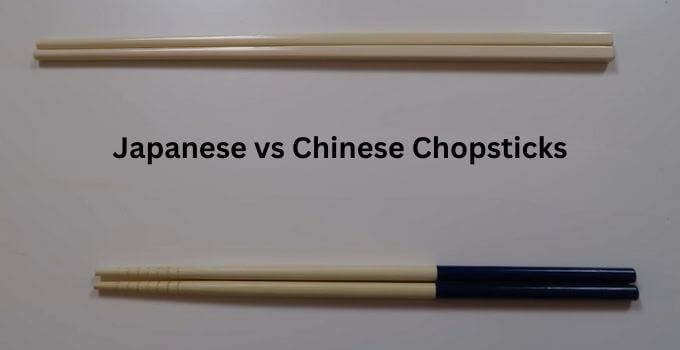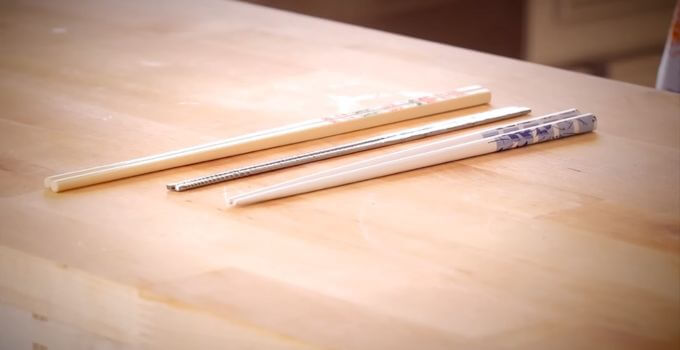
Chopsticks hold a significant place in the culinary traditions of East Asia. While they may seem similar at first glance, Japanese and Chinese chopsticks are distinct in many ways. From their design to their cultural significance, these tools reflect the unique characteristics of their respective cultures.
This article delves deep into the differences and similarities between Japanese and Chinese chopsticks, helping you understand their importance and how they are used.
Shape and Tip Design
Japanese chopsticks are typically thinner and have pointed tips. This design is perfect for picking up small or delicate food items like sushi or thin slices of sashimi. The pointed ends provide precision and make it easier to remove small bones from fish.
In contrast, Chinese chopsticks have a more robust design with a square or cylindrical shape and blunt, rounded tips. This structure is ideal for handling larger portions of food, such as noodles, rice, or stir-fried dishes. The blunt ends make them more durable for communal dining, where they are used to scoop food from shared plates or bowls.
Material Choices
The materials used in chopsticks highlight the cultural priorities of each country. Japanese chopsticks are often crafted from lacquered wood or bamboo. The lacquer finish not only adds beauty but also protects the chopsticks from wear and tear. Higher-end options may feature intricate designs, reflecting Japan’s emphasis on aesthetics.
Chinese chopsticks are more diverse in material, ranging from plain bamboo to plastic and stainless steel. Bamboo is common due to its availability and affordability. Plastic and metal chopsticks are popular for their durability and ease of cleaning. While Chinese chopsticks may lack the decorative flair of Japanese ones, they prioritize practicality.
Related: Can You Reuse Wooden Chopsticks
Length Variations
]The length of chopsticks also varies significantly between the two cultures. Japanese chopsticks are shorter, typically measuring 7 to 9 inches. The shorter length provides better control for individuals eating from their plates, which aligns with Japan’s preference for serving individual portions.
Chinese chopsticks, on the other hand, are longer, averaging 10 to 12 inches. The additional length is practical for communal dining, where diners often reach across the table to access shared dishes. This design prevents fingers from getting too close to the food, ensuring better hygiene during meals.
Related Topic: How Long Are Chopsticks
Specialized Chopsticks for Cooking
In Japan, cooking chopsticks, known as saibashi, are distinct from dining chopsticks. These are longer, often exceeding 12 inches, and are used for tasks like frying, stirring, or serving. Their length protects the user from burns while working with hot oil or steam.
China also uses chopsticks for cooking, but they are typically sturdier and more straightforward in design. Unlike Japan, where there are specific types for various culinary tasks, Chinese cooking chopsticks are versatile and serve multiple purposes in the kitchen.
Cultural Symbolism
Japanese chopsticks often carry symbolic meaning. For instance, the design or material may reflect seasonal changes or special occasions. Gift sets of chopsticks are common in Japan and are often decorated with motifs symbolizing good fortune, longevity, or harmony.
In Chinese culture, chopsticks are deeply rooted in tradition and symbolism. They are often given as gifts during weddings, symbolizing happiness and unity. The two chopsticks in a pair represent harmony and balance, a concept central to Chinese philosophy.
Food Habits and Eating Styles
The eating styles in Japan and China influence chopstick design. Japanese cuisine involves delicate foods, such as thinly sliced sashimi, sushi rolls, and small garnishes. The fine-tipped chopsticks allow precise handling, which is necessary for enjoying these intricate dishes.
Chinese meals, on the other hand, often feature hearty, shareable dishes such as stir-fries, dumplings, and large bowls of noodles. The longer and sturdier chopsticks make it easier to serve oneself from shared plates and handle large portions without breaking the food.
Textured vs. Smooth Designs
To improve grip, Japanese chopsticks sometimes have textured tips. This feature prevents slippery foods like tofu or sashimi from sliding off. The texture also helps when eating rice, especially sticky varieties commonly served in Japanese meals.
Chinese chopsticks are typically smooth from end to end. This design prioritizes ease of cleaning and durability. The smooth surface is less prone to wear, making them more suitable for frequent use, especially in households or restaurants.
Environmental Considerations
Japan frequently uses disposable chopsticks, or waribashi, in restaurants and convenience stores. These are usually made from wood and are often biodegradable. While convenient, their widespread use has raised concerns about deforestation and waste.
In contrast, Chinese chopsticks are more likely to be reusable. Many families and restaurants use plastic or metal options that last longer and reduce waste. This approach aligns with China’s practicality and growing focus on sustainability.
Craftsmanship and Traditional Methods
Japanese chopsticks often showcase the country’s artisanal craftsmanship. Many are hand-lacquered or painted with intricate designs. Traditional methods emphasize quality and attention to detail, making Japanese chopsticks highly valued as gifts or collectibles.
Chinese chopsticks, while often simpler in appearance, reflect a different kind of craftsmanship. Traditional bamboo chopsticks are handcrafted to ensure durability and practicality. Modern designs incorporate contemporary materials, balancing tradition with innovation.
Children’s Chopsticks
In Japan, children’s chopsticks are specially designed to teach proper usage. These often include training aids like rubber bands or finger grooves to help develop the correct grip. The bright, playful designs make them appealing to kids.
Chinese children typically learn with regular chopsticks. While training aids are less common, they are becoming increasingly popular among younger generations. These tools help bridge the gap between tradition and convenience for modern families.
Regional Preferences
Japan has regional variations in chopstick styles. For instance, chopsticks used in Kansai are typically shorter and rounder compared to those from other regions. This reflects the distinct culinary traditions of different areas.
China also exhibits regional differences. In northern China, where wheat-based dishes like noodles and dumplings are staples, chopsticks tend to be longer and sturdier. Southern regions, known for lighter rice-based meals, favor thinner and lighter chopsticks.
Maintenance and Care
Lacquered Japanese chopsticks require delicate care to maintain their finish. Handwashing with mild soap is recommended to prevent damage to the lacquer. Over time, they may need re-lacquering to restore their appearance.
Chinese chopsticks, especially those made of plastic or stainless steel, are easier to maintain. They can withstand machine washing and require minimal upkeep. This durability makes them a practical choice for everyday use.
Which Should You Choose?
Selecting the right chopsticks depends on personal preference and the type of cuisine you enjoy. If you frequently eat Japanese food, shorter, pointed chopsticks may feel more comfortable. For Chinese-style meals, longer chopsticks with a blunt tip work best. Understanding these differences can enhance your dining experience and deepen your appreciation for these cultural tools.
Conclusion
The distinctions between Japanese and Chinese chopsticks go beyond mere appearance. They represent the unique culinary traditions, cultural values, and practical needs of each country. Choosing the right chopsticks enhances the dining experience and offers a deeper connection to these rich traditions.
FAQs
Why are Japanese chopsticks thinner than Chinese ones?
Japanese chopsticks are designed for precision, such as handling small or delicate foods like sushi and sashimi.
What materials are used for Japanese and Chinese chopsticks?
Japanese chopsticks are often made from lacquered wood or bamboo, while Chinese chopsticks frequently use bamboo, plastic, or metal.
How do chopstick lengths differ between Japan and China?
Japanese chopsticks are shorter for better control during individual dining, while Chinese chopsticks are longer for shared meals.
Are there special chopsticks for children in Japan and China?
Yes, Japanese children’s chopsticks often have training aids, while Chinese children typically use regular chopsticks or modern training tools.
Can chopsticks reflect cultural values?
Absolutely. Japanese chopsticks often showcase intricate craftsmanship, while Chinese chopsticks emphasize practicality and symbolic meanings like harmony and balance.
